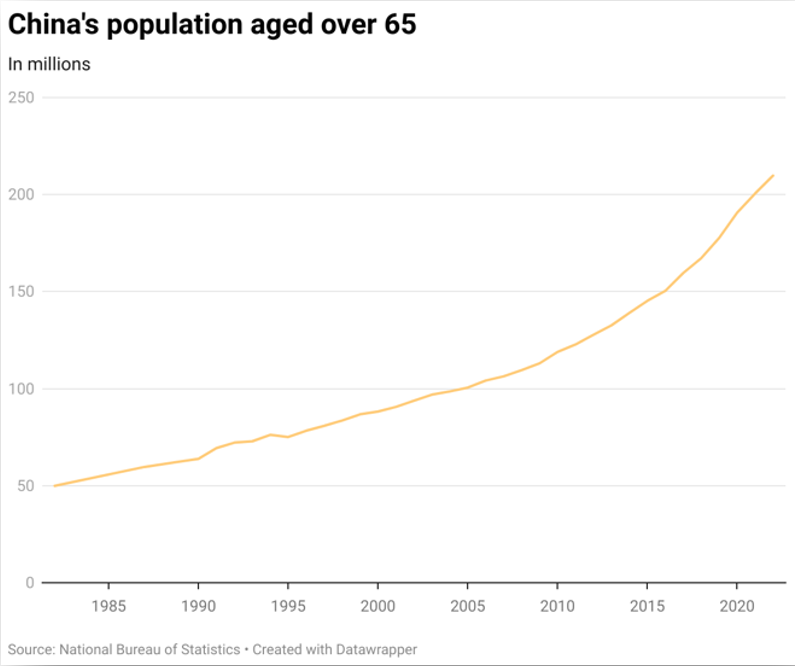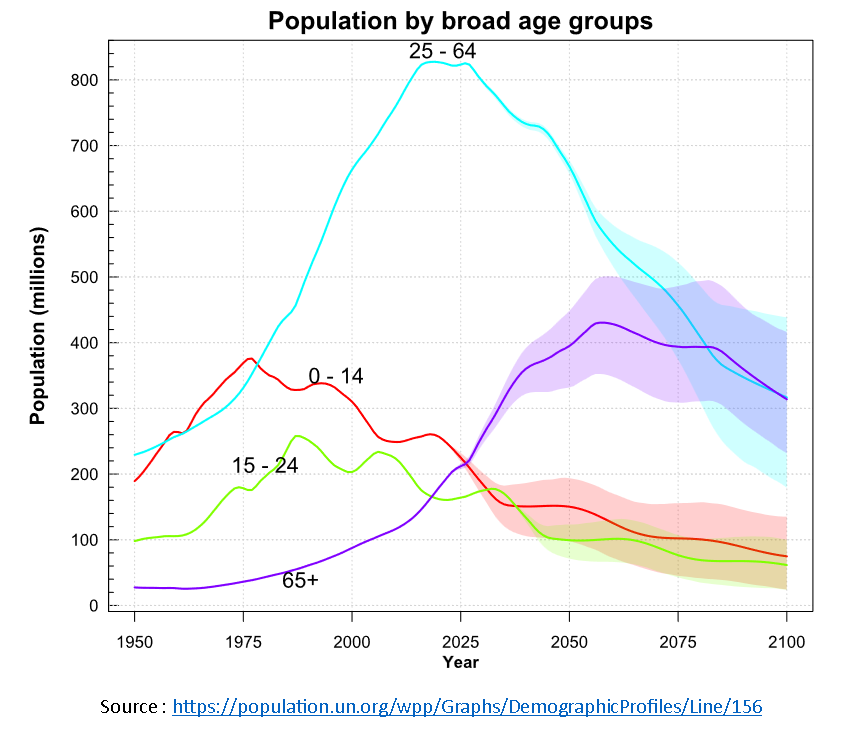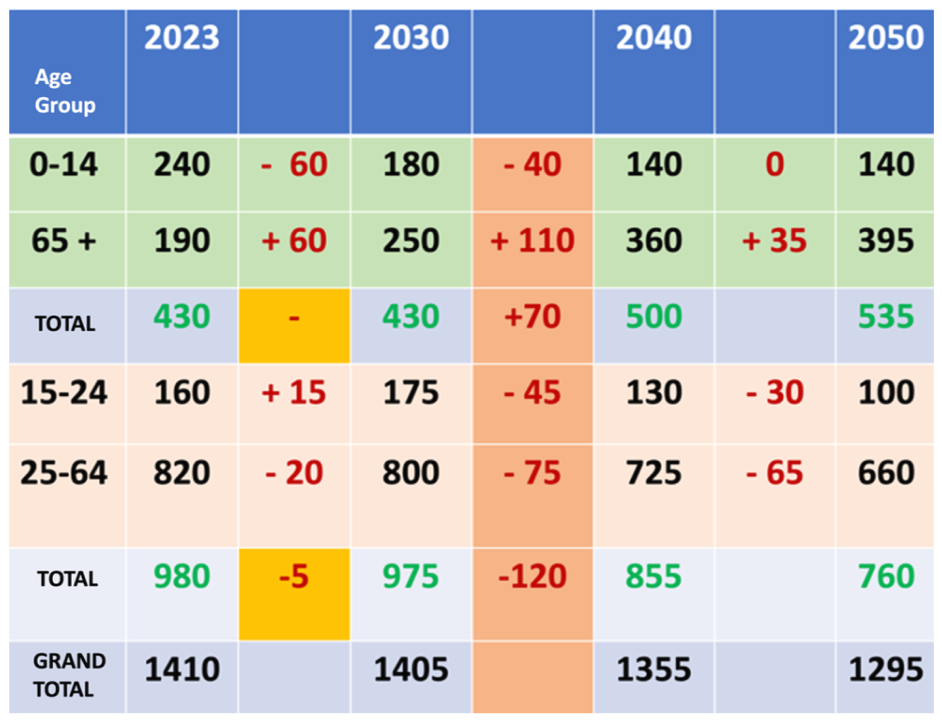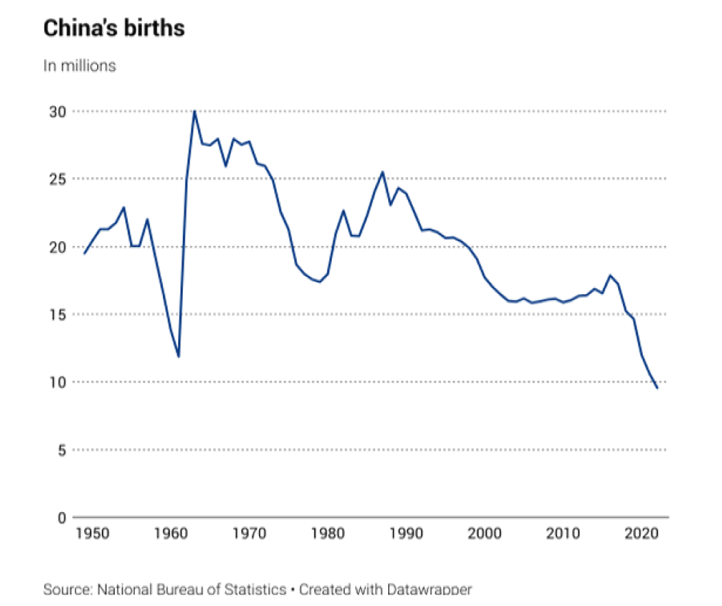Published in the Eurasian Times @ https://www.eurasiantimes.com/ncb-aging-population-low-child-births-inevitable-communist/
It is now a well-established fact that China’s declining demography is a cause for concern. I was therefore reading up on the subject when I came across the graph below which indicates China’s population aged over 65. It caught my attention since it resembled a typical run rate graph in limited overs cricket where the scoring rates in the slog overs become steep. The thought which came to my mind is that China seems to have entered the slog overs in its demographic decline. The normal thinking is that China with its ‘great leaps’ in technology, military and economy under the able leadership of Xi Jinping and his hyper enthusiastic band of communist apparatchiks will tackle the problem with their customary efficiency and zeal to march onward to a Tianxia. However they will not. Simply because they cannot. In fact they might be heading into something which they or the world have not bargained for. Let me try to forecast it by deciphering the figures.

The first issue is that while all other forecasts and statistics can be manipulated, the demographics of China are mathematical certainties (within a band). Hence the facts presented here , which is based on Chinese data, will not vary. On the other hand, given that China’s datasets are invariably inflated, the picture which emerges is the rosiest. The reality will be worse!
The Chinese demographic decline must be seen from three angles – The overall population, the working population and the aged population. However one must get the overall picture right. To get a real picture of the issue, I examined the population of China by broad age groups as published by the UN. While these graphs have been forecast till 2100, I have limited my analysis till 2040 which is the critical period in which China is GOING TO CHANGE in unforeseen ways.

The UN graph on Population by Broad Age Groups, duly converted into a table of figures is as given below. In this table the age group 0-14 and 65 + are non-working (dependent) population and have been clubbed together. The working age population – 15-24 and 25-64 has been clubbed together. The population by age group has been tabulated for 2023, 2030, 2040 and 2050. The change in the population groups between these time periods has also been highlighted.

Between 2023 and 2030, the overall decrease in Chinese population is only 5 million. However, the qualitative change starts to manifest. China would have lost 60 million in the 0-14 age group due to declining birth rates but would have added 60 million aged people who are above 65. This is because of increasing lifespans. Considering that 60 is the retirement age in China, a deeper look indicates 1/4th the population will be in the 60+ age group. In the same time frame China would have also lost 5 million working hands. By 2030 China will feel the burden of aging.
The real McCoy starts showing up in the decade between 2030 -2040. In this decade, as the total population decreases by 55 million, China will lose 40 million more in the 0-14 age group as new births keep falling and will add 110 million in the over 65 group. By then 1/3rd of China will be above 60 years of age. Simultaneously it will lose 120 million working hands (12% of its total population). Just 855 million working hands will have to take care of 500 million dependents. That is a ratio of less than 2 working hands per dependent. Beyond 2040 the situation will only deteriorate.
The Burden of an Aging Society
The data on aging has been underscored by China’s National Health Commission which expects that by 2035 , the country will have 400 million people over the age of 60 ( the retirement age for male Chinese workers). Aged people will make up more than 30 per cent of the total population by 2035 itself. This is an acceleration over the UN figures! Just think. In seven years’ time, China will have to spend considerably more on health and pensions. Can it? There are issues since the urban-worker pension fund which is the backbone of the state pension system , may run out of money by 2035 as per Chinese estimates. This is due to a decline in China’s workforce which is the main contributor for the fund! In any case China’s pension fund caters only for a small fraction of China’s total workforce which is in the state owned/public establishments. The balance of people outside this are on their own! To offset this, China is attempting to start a pension fund much like our New Pension Scheme in which designated agencies will invest in stocks and securities to generate an old age pension. However there are very few takers for it for two reasons. The value of Chinese stocks and securities are low due to the economic slump. It hardly inspires people to invest their precious life savings in them. Secondly, the Chinese people do not seem to be trusting their government which has a track record of not returning people the money deposited by them in Banks. This was evident during the bank mortgage strike in 2022 when peoples deposits on maturity were converted into some kind of securities since the banks could not repay them. Overall the situation is dire. Consider this. It took France 115 years, and Sweden 85 years, to change into ageing societies. China will become an aged society in only 25 years. The old age genie is out of the bottle and cannot be wished away.
The Plunging Birth Rates and Dwindling Population

The One Child Policy has consigned China to an irrecoverable demographic decline. The Chinese population is dwindling with abysmal birth rates (1.06) which is far below the replacement rate of 2.1. In 2022, Chinese women had 9.56 million babies (see graph above). This is the lowest total in recent Chinese history. This was also the first time the figure dipped below 10 million as can be seen from the graph above. Incidentally this graph looks like a team which has had a ‘slog over’ collapse. As per many reports the problem will only get worse. In 2023, births could further plunge to between 7- 8 million. That will be catastrophic for China. This sudden drop is a combination of many factors besides the infamous ‘One Child Policy’. It includes female foeticide during pregnancy, gender discrimination, reluctance to marry due to education and employment opportunities, late marriages, increasing cost of raising children , high divorce rates, high living expenses and more. Overall there has been a perceptible change in the Chinese public’s attitudes on getting married and starting families. China’s 2/3 child policies have not borne results despite many incentives including cash rewards. This is evident from the steep fall in birth rates. Even if by some miracle of Xi Jinping and the CCP, China’s fertility rate rebounds to 2.1 and women start having two to three children, the situation will not improve. As per Chinese experts China’s population will still continue dropping until the end of the century, due to a shrinking number of women of childbearing age as well as a rapidly ageing population. The clock of population decline cannot be turned back.
Absence of a Work Force
The cheap and unlimited work force of China which contributed to its rapid economic rise has started contracting. The “demographic dividend” is over. China’s working age population will keep on contracting as times passes. However the fall in the decade commencing 2030 will be steep. Lesser number of working people will have to support a larger section of population which is rapidly ageing or too young to work. China is trying to offset this with technology and automation. Whilst such an approach might work in smaller countries, it is doubtful if that will happen in a country as large as China. It has severe limits. Once it was propagated by the Chinese that wars could be won by technology alone and ‘boots on the ground’ approach was irrelevant. That thinking went out of the window with the Ukraine war and reinforced by the Israel-Hamas conflict. Similarly no amount of technology and automation will replace the factory worker who is vanishing in China. This phenomenon has many fall outs. Labour is going to be costly and will make Chinese manufacturing costly. China will not have farm hands at a time when Xi Jinping wants to ensure ‘Food Security’ in the face of geopolitical headwinds and climate change effects. The combination of the one child phenomenon and shrinking work force means that China will find it difficult to fill the ranks of an ever expanding PLA. As it is there are problems for the PLA to find suitable personnel. The compounding problem is that Chinese Gen Z and millennials are choosing to “lie flat (tang ping)” or “let it rot (bailan)”. Further, educated and affluent sections of China’s workforce are facing historic levels of unemployment. A record 12 million Chinese college students are about to graduate at a time when youth unemployment is as high as 25%. Overall the prospects of recovery are pretty non-existent.
End of an Innings
A nation is made of people. It is people who make or break the nation. Economy is only a part of the nation. That is something which many people miss out on when assessing China. As per some Chinese experts, ‘childbirth is the largest industry chain driving the economy’ and ‘dearth of new births would be a horrendous social and economic crisis’. This crisis is unravelling in front of our eyes. It will be in full bloom by the end of this decade. China’s abysmal birth rates, rapidly declining working age population and ageing at the fastest rate in human history is robbing the vitality of the billion plus Chinese people. It is not an uncertain but a bleak future as the PRC does not have the tools to cope with this change. In comparison, ‘Japanification’ will be a boon.
China can continue to strut around like a geopolitical colossus and Xi Jinping can keep peddling his Global Security, Development and Civilisational initiatives. The fact remains that ‘Peoples’ part is slowly diminishing in the PRC. Hence in actual fact we are seeing the end of an innings. The only issue is that as an innings comes to a close, every batsman tries to increase the run rates by frenetic swings of their bats. That is what Xi Jinping and his cohorts are doing. They have adopted a ‘six or out’ approach. Our approach should be to bowl wide yorkers, beyond reach of Xi Jinping’s bat swing.

Comments
Post a Comment